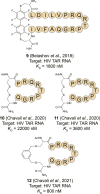RNA-Binding Macrocyclic Peptides
- PMID: 35517859
- PMCID: PMC9062085
- DOI: 10.3389/fmolb.2022.883060
RNA-Binding Macrocyclic Peptides
Abstract
Being able to effectively target RNA with potent ligands will open up a large number of potential therapeutic options. The knowledge on how to achieve this is ever expanding but an important question that remains open is what chemical matter is suitable to achieve this goal. The high flexibility of an RNA as well as its more limited chemical diversity and featureless binding sites can be difficult to target selectively but can be addressed by well-designed cyclic peptides. In this review we will provide an overview of reported cyclic peptide ligands for therapeutically relevant RNA targets and discuss the methods used to discover them. We will also provide critical insights into the properties required for potent and selective interaction and suggestions on how to assess these parameters. The use of cyclic peptides to target RNA is still in its infancy but the lessons learned from past examples can be adopted for the development of novel potent and selective ligands.
Keywords: RNA binding; macrocyclic peptides; natural products; peptide library screening; structure-based design.
Copyright © 2022 Pal and ‘t Hart.
Conflict of interest statement
The authors declare that the research was conducted in the absence of any commercial or financial relationships that could be construed as a potential conflict of interest.
Figures














Similar articles
-
The RaPID Platform for the Discovery of Pseudo-Natural Macrocyclic Peptides.Acc Chem Res. 2021 Sep 21;54(18):3604-3617. doi: 10.1021/acs.accounts.1c00391. Epub 2021 Sep 10. Acc Chem Res. 2021. PMID: 34505781
-
Structure-Based Design of Non-natural Macrocyclic Peptides That Inhibit Protein-Protein Interactions.J Med Chem. 2017 Nov 9;60(21):8982-8988. doi: 10.1021/acs.jmedchem.7b01221. Epub 2017 Oct 27. J Med Chem. 2017. PMID: 29028171 Free PMC article.
-
Phage Selection of Cyclic Peptides for Application in Research and Drug Development.Acc Chem Res. 2017 Aug 15;50(8):1866-1874. doi: 10.1021/acs.accounts.7b00184. Epub 2017 Jul 18. Acc Chem Res. 2017. PMID: 28719188
-
Construction and screening of vast libraries of natural product-like macrocyclic peptides using in vitro display technologies.Curr Opin Chem Biol. 2015 Feb;24:131-8. doi: 10.1016/j.cbpa.2014.11.011. Epub 2014 Dec 5. Curr Opin Chem Biol. 2015. PMID: 25483262 Review.
-
Targeting of extracellular protein-protein interactions with macrocyclic peptides.Curr Opin Chem Biol. 2021 Jun;62:82-89. doi: 10.1016/j.cbpa.2021.02.013. Epub 2021 Mar 26. Curr Opin Chem Biol. 2021. PMID: 33774472 Review.
Cited by
-
Tackling Undruggable Targets with Designer Peptidomimetics and Synthetic Biologics.Chem Rev. 2024 Nov 27;124(22):13020-13093. doi: 10.1021/acs.chemrev.4c00423. Epub 2024 Nov 14. Chem Rev. 2024. PMID: 39540650 Review.
-
Inverse In Vitro Selection Enables Comprehensive Analysis of Cross-Chiral L-Aptamer Interactions.Chembiochem. 2022 Dec 16;23(24):e202200520. doi: 10.1002/cbic.202200520. Epub 2022 Nov 22. Chembiochem. 2022. PMID: 36282114 Free PMC article.
References
-
- Athanassiou Z., Dias R. L. A., Moehle K., Dobson N., Varani G., Robinson J. A. (2004). Structural Mimicry of Retroviral Tat Proteins by Constrained β-Hairpin Peptidomimetics: Ligands with High Affinity and Selectivity for Viral TAR RNA Regulatory Elements. J. Am. Chem. Soc. 126, 6906–6913. 10.1021/ja0497680 - DOI - PubMed
Publication types
LinkOut - more resources
Full Text Sources
Miscellaneous

